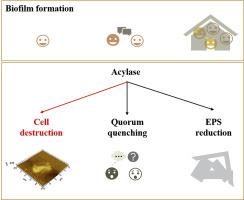Journal of Bioscience and Bioengineering ( IF 2.8 ) Pub Date : 2020-04-09 , DOI: 10.1016/j.jbiosc.2020.02.005 Qian Bao 1 , Ayaka Hosoe 1 , Masaaki Hosomi 1 , Akihiko Terada 1

|
Acylase is known as a quorum quenching enzyme that degrades N-acyl-homoserine lactones (AHLs), a key signaling molecule in a quorum sensing (QS) mechanism. Acylase I cleaves the acyl-chain in the chemical structures of AHLs, thereby exerting an anti-biofilm effect by the inhibition of bacterial cell–cell communication and resultant secretion of extracellular polymeric substances (EPS). However, the physical and physiological impacts of acylase on bacterial cells remain to be systematically elucidated. This study, therefore, investigated the effect of active and inactive acylase addition on the growth, viability, and cell morphologies of Agrobacterium tumefaciens. For comparison, active and inactive lysozymes were taken as positive controls. The results showed that active acylase inhibited A. tumefaciens cell growth at concentrations ranging from 0.1 to 1000 μg mL−1, and so did active lysozyme. Fluorescent detection by Live/Dead staining underpinned that cell viability of A. tumefaciens decreased at concentrations higher than 0.1 μg mL−1 for both acylase and lysozyme, although lysozyme inflicted higher degree of cellular damage. Moreover, atomic force microscopy unraveled a noticeable distortion of A. tumefaciens cells by both acylase and lysozyme. Together, the results showed that acylase not only blocked AHLs-based QS mechanisms but also compromised cell viability and altered surface morphology of A. tumefaciens cells, as observed by the addition of hydrolase.
中文翻译:

群体猝灭酰基转移酶影响根癌农杆菌细胞的活力和形态变化。
酰基转移酶被称为群体猝灭酶,它降解N-酰基-高丝氨酸内酯(AHL),这是群体感应(QS)机制中的关键信号分子。酰化酶I会切割AHL的化学结构中的酰基链,从而通过抑制细菌细胞之间的通讯以及由此产生的胞外聚合物质(EPS)的分泌来发挥抗生物膜作用。然而,酰基转移酶对细菌细胞的物理和生理影响仍有待系统地阐明。因此,这项研究调查了活性和非活性酰基转移酶添加对根癌农杆菌生长,活力和细胞形态的影响。。为了比较,将活性和非活性溶菌酶作为阳性对照。结果显示,活性酰基转移酶在浓度范围为0.1至1000μgmL -1的情况下抑制根癌农杆菌细胞生长,活性溶菌酶也是如此。通过活/死染色进行的荧光检测证实,尽管溶菌酶对细胞的破坏程度较高,但对于酰基转移酶和溶菌酶而言,根癌土壤杆菌的细胞活力在浓度均高于0.1μgmL -1时会降低。此外,原子力显微镜揭示了根癌农杆菌的明显变形。酰基转移酶和溶菌酶共同作用 在一起,结果表明,通过添加水解酶观察到,酰基转移酶不仅阻断了基于AHLs的QS机制,而且还损害了细胞活力并改变了根癌农杆菌细胞的表面形态。



























 京公网安备 11010802027423号
京公网安备 11010802027423号